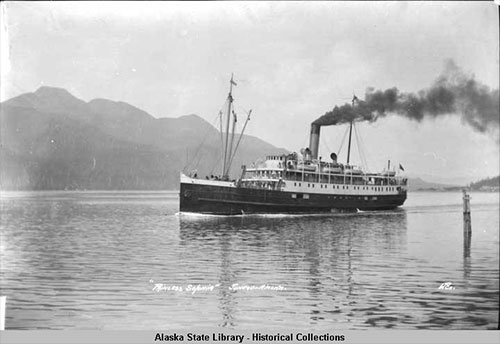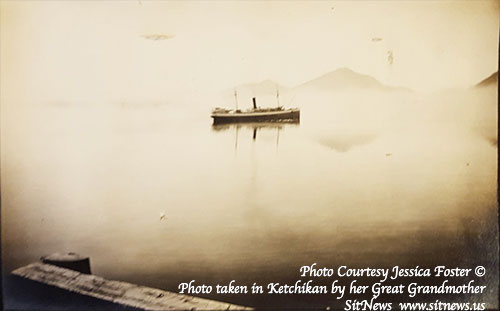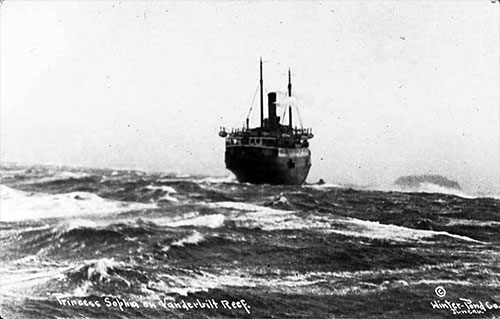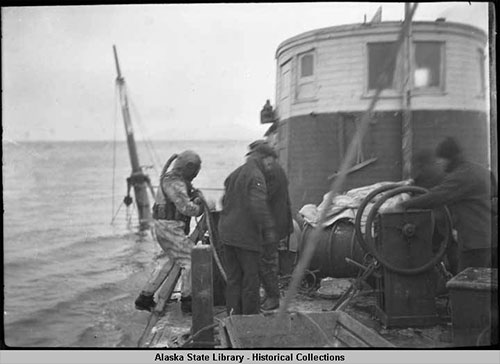
Princess Sophia Sank 100 Years Ago350 passengers, crew died in the waters near JuneauBy DAVE KIFFER
October 23, 2018
The story itself has been the subject of two books, a play, a musical, a upcoming opera, and numerous historical articles (See "The Grounding of the Princess Sophia," SITNEWS, Dec. 5. 2005). And yet, it is a story that often surprises the residents of Southeast Alaska when they hear about it.
Discussion of the sinking of the Canadian Railway ship often feels like a story of a time from the depths of history rather than something that happened when the grandparents of today's residents were around. Although the sinking of the Canadian Pacific Railway steamer and the loss of all aboard put many in mind of the Titanic disaster six years before, it wasn't long before other news events knocked it off the front pages and it became a footnote in the history of the Inside Passage. First of all, World War I came to an end barely three weeks later. And the Great Influenza of 1918 was also killing millions of people world-wide and also seriously affecting Alaska and the North Coast (See "When the Great Influenza Shut Down Ketchikan, SITNEWS, Nov. 26, 2008).
Even the sinking of the Sophia itself was only one part of the strongest recorded storms to ever hit northern British Columbia and Southeast Alaska (See "The Killer Storm of October, 1918, SITNEWS, Oct. 25, 2008) So, while the sinking of the Princess Sophia was a major tragedy that shocked residents up and down the coast, as well as deep into the Yukon Territory because a great many of the people who died were prominent citizens of the Klondike, the incident itself quickly faded from the public consciousness. It became just another tragedy along a coast where ship sinkings were all too common in an era with few safety measures taken to deal with the numerous hazards to navigation. Ironically, the Canadian Pacific line had asked the United State Lighthouse Service (the forerunner of the US Coast Guard) to put a light on Vanderbilt Reef in 1917 because of concerns over the narrowness of Lynn Canal at that point and the heavy winds that blew ships off course during area storms. At the time of the grounding there was only a small unlit buoy to mark the reef. But with American resources being funneled towards the war in Europe, the request was put off. Two years after the sinking a navigational beacon would be put on the reef. What happened to the ship is well known. The why is less clear. The Sophia was making its last run of the season south from Skagway on Oct. 23, 1918. Because it was the Sophia's last run last run of the season, the ship was full and many of the passengers were people who lived and worked in the Klondike during the summer mining season and were heading for warmer climes for the next few months. It has been estimated that 125 of the victims were residents of Dawson City. More than 70 people on board were employed by the White Pass Railway and its steamship operations.
One of the most notable passengers was Walter Harper, 25, the first person to stand on the summit of Mount Denali (Mt. McKinley). Harper, a Koyukon Native and his wife Frances, were on the Sophia for a honeymoon trip to Philadelphia where Harper was slated to study medicine and join the Red Cross. It was the grave of Harper and his wife, in Juneau’s Evergreen Cemetery, that inspired Juneau writer Mary Lou Spartz’ lifelong interest in the Princess Sophia and its passengers. Spartz grew up next to the cemetery. “I liked to read the grave markers,” Spartz, 86, told the Juneau Empire in May of 2018. “One day, while going on my walk, I read a grave marker about the ship that sank and the two people who were on it. The graves were of Walter Harper and his wife, Frances Welles Harper. It was very romantic that the two people died together and were buried together. I asked my dad about it and I was just fixated on it.” Also on the ship was Lula Mae Eads, a former Klondike dance hall queen who many suggest was the inspiration for Robert Service’s famous “Lady that’s known as Lou” in “The Shooting of Dan McGrew.” Spartz would go on to write a play about the Sophia and her work is important to an opera that is in production about the sinking. Spartz has also been part of a Juneau committee to commemorate the ship and its passengers and crew. The committee worked to get a memorial plaque dedicated at Eagle Beach north of Juneau in July of this year.
Eagle Beach is one of the nearest points to Vanderbilt Reef, some 12 miles north of Juneau's Auk Bay. The Princess Sophia hit the reef at full speed at 2 am during a gale in which the winds were estimated at 50 mph and visibility was near zero in the dark and snow. Initially, the ship seemed stable on the reef as the wind storm continued. Numerous photos taken from the responding ships indicated the line was sitting up fairly straight on the reef but it was not clear how much damage the grounding had done to the hull. What happened next, as the sun came up on October 24, continues to be debated. Ship Captain Leonard Locke, a veteran of 30 years sailing on the Inside Passage, declined suggestions to evacuate the passengers and crew. Locke radioed that the continued high winds (still gusting up to 60 mph) would make the evacuation too dangerous. The ship sat on the reef the rest of the day, Oct. 24. Plans were made to evacuate the passengers early the next day. But overnight the storm worsed. Winds increased and waves reached 25 feet in Lynn Canal. They combined with the rising tide to eventually lift the ship off the reef in the dark around 5 pm. The hull broke apart and the ship sank in 60 feet of water next to the reef. There were no survivors. Except for a dog. Maybe. There were numerous reports in Juneau that an oil slicked English setter was found on the beach at Auk Bay after the sinking. But it was never conclusively determined whether the dog was from the wreck. It was also never determined exactly how many people died when the Sophia foundered because passenger and crew records went down with the ship. In addition to Juneau, Skagway has in recent years has moved to commemorate the sinking of the ship that left its harbor on October 23rd. The Skagway Museum hosted an exhibit on the Princess Sophia this summer. And plans have been made for a historical marker in Skagway’s Centennial Park.
In 2007, Dawson City – the community hardest hit by the disaster – put up a memorial park overlooking the Yukon River. The plaques at the memorial park tried to fill in some of the historical unknowns by including the names of at least 25 additional people who were probably on the ship at the time of the sinking but were not listed in the contemporary records. It had been estimated that at least 400 people were attempting to get passage out of the Skagway on Oct. 23 and that some had been allowed to board the steamer at the last minute. On Oct. 25-27, 2018, the Orpheus Project will stage “The Princess Sophia” opera in Juneau. The libretto (story) is by Dave Hunsaker and the music is by Emerson Eads – no relation to Lula Mae. The famous surviving dog will have a cameo, according to a September 2018 story in the Juneau Empire. At least one aria in the opera will reportedly be a recitation of the names of the dead. With many of the victims of the tragedy buried in Evergreen Cemetery, it is not surprising that some can feel the spirit of the Princess Sophia in the Capital City. But some say there may be even more to it than that. The basement area of the Juneau Drug is one place where some say they can feel the tragedy. Employees at the store say “the room” downstairs is a place they don’t like to visit. When the ship sank, many places in Juneau’s downtown became makeshift morgues, including what is now below Juneau Drug. Employees at the Drug store told the Juneau Empire last year that they have had several unexplained, almost spectral, events happen to them in the basement area of the building, where at least two dozen bodies were stored in 1918. A child’s ghost was reportedly seen and employees have reported being touched by sudden cold presences. As a result, they told the Empire, they prefer to avoid the basement, if at all possible. Meanwhile, the Princess Sophia itself remains at the bottom of Lynn Canal still partially resting on Vanderbilt Reef. Because of its relative shallowness it is a popular site for recreational divers. When the weather cooperates.
On the Web:
Contact Dave at dave@sitnews.us Dave Kiffer ©2018 Publication fee required. © Representations of fact and opinions in comments posted are solely those of the individual posters and do not represent the opinions of Sitnews.
|
|||||||




